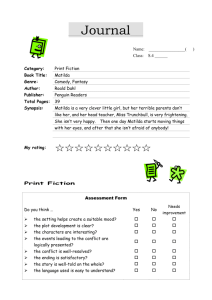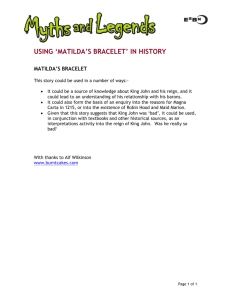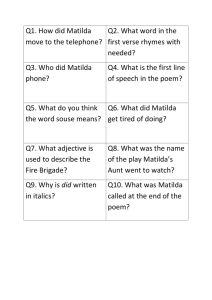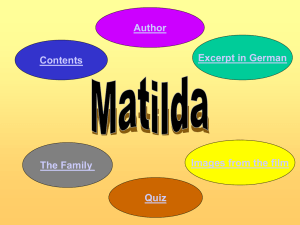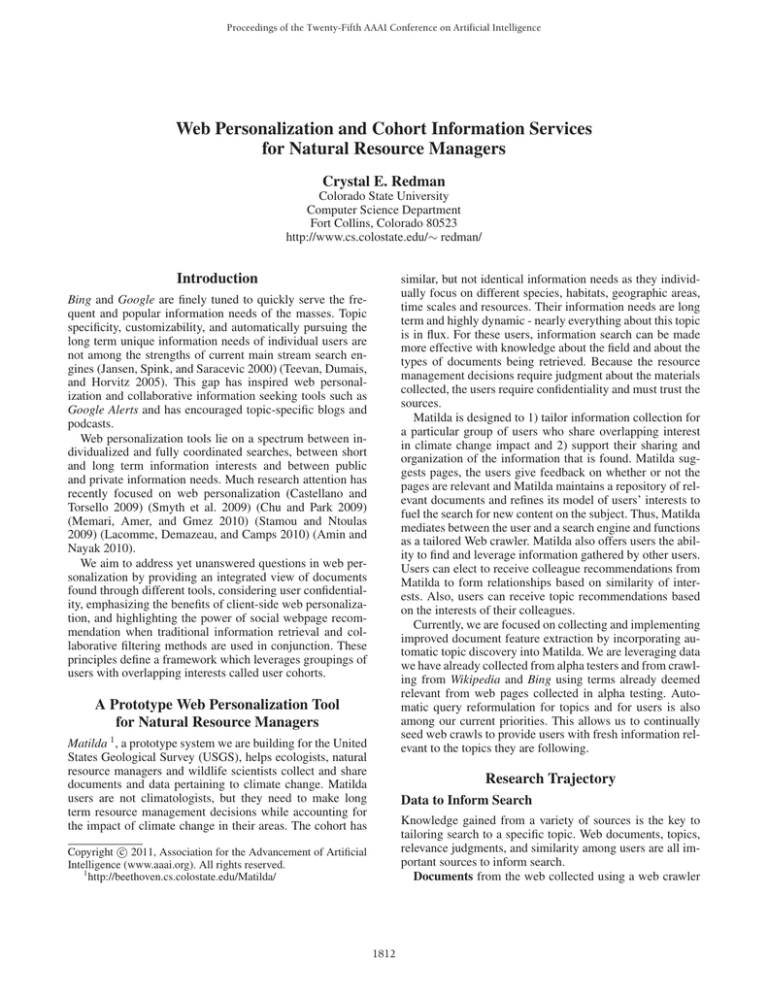
Proceedings of the Twenty-Fifth AAAI Conference on Artificial Intelligence
Web Personalization and Cohort Information Services
for Natural Resource Managers
Crystal E. Redman
Colorado State University
Computer Science Department
Fort Collins, Colorado 80523
http://www.cs.colostate.edu/∼ redman/
Introduction
similar, but not identical information needs as they individually focus on different species, habitats, geographic areas,
time scales and resources. Their information needs are long
term and highly dynamic - nearly everything about this topic
is in flux. For these users, information search can be made
more effective with knowledge about the field and about the
types of documents being retrieved. Because the resource
management decisions require judgment about the materials
collected, the users require confidentiality and must trust the
sources.
Matilda is designed to 1) tailor information collection for
a particular group of users who share overlapping interest
in climate change impact and 2) support their sharing and
organization of the information that is found. Matilda suggests pages, the users give feedback on whether or not the
pages are relevant and Matilda maintains a repository of relevant documents and refines its model of users’ interests to
fuel the search for new content on the subject. Thus, Matilda
mediates between the user and a search engine and functions
as a tailored Web crawler. Matilda also offers users the ability to find and leverage information gathered by other users.
Users can elect to receive colleague recommendations from
Matilda to form relationships based on similarity of interests. Also, users can receive topic recommendations based
on the interests of their colleagues.
Currently, we are focused on collecting and implementing
improved document feature extraction by incorporating automatic topic discovery into Matilda. We are leveraging data
we have already collected from alpha testers and from crawling from Wikipedia and Bing using terms already deemed
relevant from web pages collected in alpha testing. Automatic query reformulation for topics and for users is also
among our current priorities. This allows us to continually
seed web crawls to provide users with fresh information relevant to the topics they are following.
Bing and Google are finely tuned to quickly serve the frequent and popular information needs of the masses. Topic
specificity, customizability, and automatically pursuing the
long term unique information needs of individual users are
not among the strengths of current main stream search engines (Jansen, Spink, and Saracevic 2000) (Teevan, Dumais,
and Horvitz 2005). This gap has inspired web personalization and collaborative information seeking tools such as
Google Alerts and has encouraged topic-specific blogs and
podcasts.
Web personalization tools lie on a spectrum between individualized and fully coordinated searches, between short
and long term information interests and between public
and private information needs. Much research attention has
recently focused on web personalization (Castellano and
Torsello 2009) (Smyth et al. 2009) (Chu and Park 2009)
(Memari, Amer, and Gmez 2010) (Stamou and Ntoulas
2009) (Lacomme, Demazeau, and Camps 2010) (Amin and
Nayak 2010).
We aim to address yet unanswered questions in web personalization by providing an integrated view of documents
found through different tools, considering user confidentiality, emphasizing the benefits of client-side web personalization, and highlighting the power of social webpage recommendation when traditional information retrieval and collaborative filtering methods are used in conjunction. These
principles define a framework which leverages groupings of
users with overlapping interests called user cohorts.
A Prototype Web Personalization Tool
for Natural Resource Managers
Matilda 1 , a prototype system we are building for the United
States Geological Survey (USGS), helps ecologists, natural
resource managers and wildlife scientists collect and share
documents and data pertaining to climate change. Matilda
users are not climatologists, but they need to make long
term resource management decisions while accounting for
the impact of climate change in their areas. The cohort has
Research Trajectory
Data to Inform Search
Knowledge gained from a variety of sources is the key to
tailoring search to a specific topic. Web documents, topics,
relevance judgments, and similarity among users are all important sources to inform search.
Documents from the web collected using a web crawler
c 2011, Association for the Advancement of Artificial
Copyright Intelligence (www.aaai.org). All rights reserved.
1
http://beethoven.cs.colostate.edu/Matilda/
1812
and by allowing users to contribute pointers directly are
maintained in a repository. Using these web documents, we
calculate features such as a variant of TFIDF, type of document, and important phrases. In the future, we will incorporate features such as prose sophistication, readability, associations with reputable authors, and citation trails. Though
we currently focus just on HTML documents, but intend to
include other types of documents like pdf files to provide
users with documents from peer reviewed sources.
Topics are an important way to organize web personalization tools. In Matilda, users initially describe the topic
and provide relevance feedback for documents suggested
for the topic. Currently, any user who indicates an interest
in the topic will be receive recommendations for all pages
other users following that topic have recommended highly.
In the future, machine learning algorithms will be used to
analyze the feedback to create user specific and cohort specific topics. A current open question is whether initializing
with expert domain knowledge and automatically updating
the subtopics of a specific domain like climate change will
improve topic specific search. Another question is when and
how topics should be coalesced or separated.
Relevance judgments can be used to refine document relevance. We allow the user to determine whether a suggested
document is relevant to one or more topics. To leverage a
variety of collaborative filtering algorithms, we will use a
five valued relevance feedback mechanism. We believe that
combining collaborative filtering and information retrieval
algorithms will strengthen the recommendations the user receives especially for topics that are not widely followed by
the typical user.
Cohort membership, whether intentional or inferred, is
used to provide personalized weightings for recommendations. Significant overlap in the topics a group of users are
following can define a collaborative topic model. In the future, Matilda will consider together the topics a user is following, colleague relationships, and user trust in making
recommendations. For example, does a specific user consistently contribute recommendations to other members of the
cohort which are well received? Privacy will also becomes
an important factor as cohort membership functionality is
embellished.
and metrics can be adapted given the small subset of data
that is actually labeled with topic specificity or relevance
feedback. We will be further investigating clustering algorithms to eliminate terms which do not contribute to the
model, allow for missing relevance feedback, determine the
topic subsets, and preprocess document sets and relevance
feedback data using dimension reduction techniques.
Acknowledgement
This research is supported by a grant from the USGS to Colorado State University.
References
Amin, M., and Nayak, R. 2010. Theoretical model of user
acceptance: In the view of measuring success in web personalization. In Forbrig, P.; Patern, F.; and Mark Pejtersen,
A., eds., Human-Computer Interaction, volume 332 of IFIP
Advances in Information and Communication Technology.
Springer Boston. 255–264.
Castellano, G., and Torsello, M. 2009. How to derive fuzzy
user categories for web personalization. In Castellano, G.;
Jain, L.; and Fanelli, A., eds., Web Personalization in Intelligent Environments, volume 229 of Studies in Computational
Intelligence. Springer Berlin / Heidelberg. 65–79.
Chu, W., and Park, S.-T. 2009. Personalized recommendation on dynamic content using predictive bilinear models. In Proceedings of the 18th international conference
on World wide web, WWW ’09, 691–700. New York, NY,
USA: ACM.
Jansen, B. J.; Spink, A.; and Saracevic, T. 2000. Real
life, real users, and real needs: a study and analysis of user
queries on the web. Inf. Process. Manage. 36:207–227.
Lacomme, L.; Demazeau, Y.; and Camps, V. 2010. How
to integrate personalization and trust in an agent network.
In Filipe, J.; Fred, A.; and Sharp, B., eds., Agents and Artificial Intelligence, volume 67 of Communications in Computer and Information Science. Springer Berlin Heidelberg.
247–259.
Memari, A.; Amer, M.; and Gmez, J. M. 2010. A beehivelike multi-agent solution to enhance findability of semantic
web services and facilitate personalization within a p2p network. In Davcev, D., and Gmez, J. M., eds., ICT Innovations
2009. Springer Berlin Heidelberg. 227–236.
Smyth, B.; Briggs, P.; Coyle, M.; and OMahony, M. 2009.
Google shared. a case-study in social search. In Houben, G.J.; McCalla, G.; Pianesi, F.; and Zancanaro, M., eds., User
Modeling, Adaptation, and Personalization, volume 5535 of
Lecture Notes in Computer Science. Springer Berlin / Heidelberg. 283–294.
Stamou, S., and Ntoulas, A. 2009. Search personalization
through query and page topical analysis. User Modeling and
User-Adapted Interaction 19:5–33.
Teevan, J.; Dumais, S. T.; and Horvitz, E. 2005. Beyond
the commons: Investigating the value of personalizing web
search. In In Proceedings of the Workshop on New Technologies for Personalized Information Access, 84–92.
Automatic Topic Discovery and Organization
From alpha testing we have completed with a cadre of natural resource manager users, we have collected many webpages the users have judged relevant. These pages along
with well known government web sites, such as the USGS
web site, can be crawled for terms that are related to climate
change. These terms can then be used to seed crawls from
Wikipedia, Bing, or Google searches. Using the results from
these crawls, we can get a better idea of the sub-topics that
define climate change and create a better, somewhat automatic listing of topics to present to users.
Clustering Algorithms for Profiling
Unsupervised and semi-supervised clustering algorithms are
useful in personalized and cohort document search because
user feedback can be introduced into the clustering process
1813

